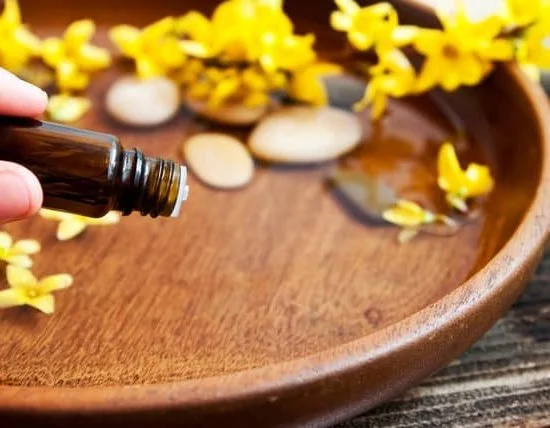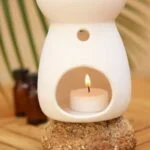Peppermint aromatherapy has gained popularity in recent years for its numerous benefits and soothing effects on the mind and body. This article will delve into the science behind peppermint aromatherapy, its potential benefits, and different methods of using it. Whether you are seeking a natural remedy to boost your energy levels or relieve physical discomforts, peppermint aromatherapy may be worth exploring.
Peppermint aromatherapy is the use of essential oil derived from peppermint plants to promote overall well-being. The scent of peppermint is known for its invigorating and uplifting qualities, which make it a popular choice among individuals seeking relaxation and stress relief. Additionally, peppermint aromatherapy offers potential benefits such as boosting mental alertness, relieving physical discomforts, and reducing stress and anxiety.
Many people turn to peppermint aromatherapy as a natural alternative to pharmaceutical options due to its perceived effectiveness and lack of harmful side effects. The scent of peppermint can stimulate receptors in the brain that promote improved focus and enhanced cognitive function. As a result, it has become popular amongst students or individuals looking to heighten their mental clarity.
In the following sections, we will explore the science behind peppermint aromatherapy, examine its various benefits for both the mind and body, discuss different methods of using it, provide tips on choosing the right essential oil, blends, appropriate precautions for safe usage. Ultimately we will discover how harnessing the power of peppermint aromatherapy can contribute to overall well-being.
The Science Behind Peppermint Aromatherapy
Peppermint aromatherapy is a popular practice that has been used for centuries to promote relaxation, relieve stress, and enhance overall well-being. But how exactly does it work? The science behind peppermint aromatherapy lies in the powerful compounds found in the essential oil of the peppermint plant.
The main active compound in peppermint essential oil is menthol, which is known for its cooling and refreshing properties. When we inhale the scent of peppermint, molecules of menthol bind to receptors in our nasal cavity, activating a signal that is sent to our brain. This signal triggers a cascade of effects that can have a profound impact on our body and mind.
One key effect of peppermint aromatherapy is its ability to stimulate the production of endorphins in the brain. Endorphins are natural chemicals that act as painkillers and mood boosters, promoting feelings of pleasure and relaxation. This can help to reduce stress and improve overall mood.
Additionally, menthol has been shown to have anti-inflammatory properties. When we inhale or apply peppermint essential oil topically, it can help reduce inflammation in the body by inhibiting certain enzymes involved in the inflammatory response. This makes peppermint aromatherapy particularly effective for relieving headaches, muscle pains, and other physical discomforts.
Overall, the science behind peppermint aromatherapy suggests that it works by targeting our brain and nervous system through inhalation or topical application. By stimulating the production of endorphins and reducing inflammation, it can provide numerous benefits for both our physical and mental well-being.
Benefits of Peppermint Aromatherapy
Peppermint aromatherapy offers a wide range of benefits for both the mind and body. The soothing properties of peppermint oil can provide relief from various conditions and promote overall well-being. Here are some of the key benefits of peppermint aromatherapy:
- Relaxation and Stress Relief: Peppermint aromatherapy has been found to have a calming effect on the mind, helping to reduce stress, anxiety, and nervousness. Inhaling the aroma of peppermint essential oil can activate certain receptors in the brain that promote relaxation and improve mood. This makes it an effective tool for relieving tension and inducing a sense of tranquility.
- Enhanced Focus and Mental Clarity: Peppermint aromatherapy is known for its ability to boost mental alertness and concentration. The refreshing scent of peppermint can stimulate the brain, increase oxygen flow, and enhance cognitive function. Whether you’re studying for exams or need to stay focused at work, using peppermint essential oil through diffusion or inhalation methods can help sharpen your mental clarity.
- Muscle Relaxation and Pain Relief: Peppermint essential oil contains menthol, which possesses analgesic properties that can help alleviate muscle pain, soreness, and tension. It acts as a natural muscle relaxant, making it an ideal choice for relieving headaches, migraines, and even menstrual cramps. When applied topically or used in a hot bath, peppermint aromatherapy can provide immediate relief from physical discomforts.
To fully enjoy these benefits, there are different methods of using peppermint aromatherapy depending on personal preference or specific needs. Inhalation is one common method where you can add a few drops of essential oil to a diffuser or inhale directly from the bottle.
Topical application involves diluting the oil with a carrier oil such as coconut or almond oil before applying it onto the skin for massage purposes or targeted pain relief. Finally, diffusion allows you to disperse the scent throughout a room using a diffuser or even by adding a few drops to a warm bath.
As with any essential oil, it is important to choose high-quality peppermint essential oil and blends for aromatherapy purposes. Look for oils that are 100% pure and therapeutic grade to ensure the best results. Additionally, it’s crucial to follow precautions and use peppermint aromatherapy safely.
Some individuals may have sensitivities or allergies to essential oils, so doing a patch test before use is recommended. Pregnant women, young children, and individuals with certain medical conditions should consult with a healthcare professional before using peppermint aromatherapy.
Overall, the benefits of peppermint aromatherapy make it a popular choice for promoting relaxation, mental clarity, pain relief, and overall well-being. By harnessing the power of this versatile essential oil through various methods of usage, you can enjoy its soothing effects on both the mind and body.
How Peppermint Aromatherapy Can Boost Energy and Mental Alertness
Peppermint aromatherapy is not only known for its refreshing and invigorating scent, but it can also provide a natural boost of energy and enhance mental alertness. This section explores how peppermint aromatherapy can help increase energy levels and improve cognitive function.
One of the main reasons why peppermint aromatherapy is believed to boost energy is due to its stimulating properties. The aroma of peppermint essential oil has been found to stimulate the brain and enhance focus, attention, and mental clarity. When inhaled, the scent of peppermint activates the limbic system in the brain, which plays a crucial role in regulating emotions, memory, and motivation.
In addition to its stimulant effects on the brain, peppermint aromatherapy can also improve physical energy levels. The scent of peppermint has been shown to increase oxygen levels in the blood and promote better circulation throughout the body. This improved blood flow can lead to increased stamina and physical energy.
Using peppermint aromatherapy for boosting energy and mental alertness can be as simple as inhaling the scent directly from the bottle or using a diffuser. Another method is diluting a few drops of peppermint essential oil with a carrier oil like coconut or jojoba oil, and applying it topically to pulse points such as wrists or temples. Remember to do a patch test before applying essential oils topically to ensure you do not have any adverse reactions.
In summary, incorporating peppermint aromatherapy into your daily routine can provide a natural way to boost energy levels and improve mental alertness. Whether you choose to inhale it directly or apply it topically, harnessing the power of peppermint essential oil can provide an uplifting energy that helps you stay focused and alert throughout your day.
Relieving Physical Discomforts with Peppermint Aromatherapy
Peppermint aromatherapy not only has a refreshing and invigorating scent, but it also has several benefits in relieving physical discomforts. The menthol compound found in peppermint has analgesic properties that can help reduce pain and discomfort in various parts of the body. Let’s explore some of the ways peppermint aromatherapy can provide relief from physical ailments.
Muscle Pain and Soreness
One of the main benefits of peppermint aromatherapy is its ability to alleviate muscle pain and soreness. When applied topically or inhaled, the cooling sensation of menthol helps relax tight muscles, reduce inflammation, and increase blood flow to the affected areas.
This makes it an excellent choice for athletes or individuals experiencing muscle aches due to overexertion or injury. To use peppermint aromatherapy for muscle pain relief, you can dilute peppermint essential oil with carrier oil and apply it directly to the affected area for massage or use a diffuser to inhale the aroma.
Headaches and Migraines
Peppermint aromatherapy has been shown to be effective in alleviating headaches and migraines. The cooling sensation produced by menthol helps ease tension in the head and neck muscles, which is often a common cause of headaches. Inhalation of peppermint essential oil can provide quick relief by reducing pain intensity and promoting relaxation. You can add a few drops of peppermint essential oil to a tissue or inhaler and inhale deeply whenever you feel a headache coming on.
Digestive Issues
Peppermint aromatherapy is also commonly used to relieve digestive issues such as indigestion, gas, bloating, and nausea. Peppermint has antispasmodic properties that can help relax the muscles of the gastrointestinal tract, promoting proper digestion and reducing discomfort.
Inhaling peppermint essential oil or using it topically on the abdomen can provide relief from digestive symptoms. However, it is important to note that individuals with gastroesophageal reflux disease (GERD) may experience worsened symptoms with peppermint aromatherapy, as it can relax the lower esophageal sphincter.
Peppermint aromatherapy offers a natural and effective solution for relieving various physical discomforts. Whether you are dealing with muscle pain, headaches, or digestive issues, incorporating peppermint aromatherapy into your self-care routine can provide much-needed relief. It is always advisable to consult with a healthcare professional before using peppermint essential oil, especially if you have any underlying medical conditions or are pregnant/nursing.
Peppermint Aromatherapy for Stress and Anxiety Relief
Understanding the Impact of Stress and Anxiety
Stress and anxiety have become pervasive issues in today’s fast-paced society, affecting millions of people worldwide. The pressures of work, relationships, finances, and other responsibilities can easily lead to feelings of overwhelm, tension, and unease. Extended periods of stress can have detrimental effects on both mental and physical health if left unaddressed.
The Calming Effects of Peppermint Aromatherapy
Peppermint aromatherapy offers a natural solution for managing stress and anxiety. The refreshing scent of peppermint has been found to have calming effects on the mind and body when used as an essential oil or fragrance. Inhaling the aroma of peppermint triggers a response in the brain that helps reduce feelings of stress by promoting relaxation and a sense of ease.
Studies have shown that exposure to peppermint aroma can help decrease levels of cortisol, which is known as the “stress hormone.” By reducing cortisol levels, peppermint aromatherapy can alleviate symptoms of stress such as tension headaches, muscle tightness, and restlessness. It can also improve overall mood by stimulating the release of endorphins, which are natural feel-good chemicals in the brain.
Effective Application Methods for Stress Relief
There are various ways to incorporate peppermint aromatherapy into your daily routine to manage stress and anxiety effectively. Inhalation is one popular method which involves directly inhaling the scent from a bottle or using a diffuser. This allows the molecules in the essential oil to enter your body through inhalation and quickly reach your brain.
Another effective method is topical application. Diluting a few drops of peppermint essential oil with a carrier oil like coconut or jojoba oil before applying it to pulse points such as wrists or temples can provide immediate relief from stress and anxiety. The scent of peppermint can be released throughout the day, acting as a constant source of relaxation.
Different Methods of Using Peppermint Aromatherapy
Peppermint aromatherapy can be used in various ways to reap its therapeutic benefits. There are three main methods of using peppermint aromatherapy: inhalation, topical application, and diffusion. Each method provides unique advantages and allows individuals to personalize their experience with peppermint essential oil.
- Inhalation: One of the most popular and effective ways to use peppermint aromatherapy is through inhalation. This can be done by adding a few drops of peppermint essential oil to a diffuser or by creating a steam inhalation.
To create a steam inhalation, simply add a few drops of peppermint essential oil to hot water, cover your head with a towel, and inhale the steam deeply. Inhalation allows the scent of peppermint to reach your olfactory system, triggering various neurological responses that can help alleviate discomforts and promote relaxation. - Topical Application: Another way to enjoy the benefits of peppermint aromatherapy is through topical application. Diluting mint essential oil with a carrier oil such as coconut or jojoba oil is important before applying it directly on the skin. This method is particularly useful for relieving physical discomforts such as muscle soreness or tension headaches. Gently massaging the diluted mixture onto the affected area can provide cooling and soothing effects.
- Diffusion: Diffusing peppermint essential oil into the air is an effective way to experience its aromatic benefits throughout a room or space. Using an electronic diffuser or reed diffuser, place a few drops of peppermint essential oil into the diffuser, allowing it to disperse into the air over time. This method not only creates a pleasant atmosphere but also helps improve focus and mental alertness due to the inhalation of peppermint aroma.
By incorporating different methods of using peppermint aromatherapy into your daily routine, you can optimize its various benefits for both your mind and body. Whether you prefer inhalation, topical application, or diffusion, peppermint essential oil can be easily customized to suit your preferences and needs. It is essential to note that individuals may respond differently to different methods of application, so it is important to find the one that works best for you.
Choosing the Right Peppermint Essential Oil and Blends for Aromatherapy
When using peppermint aromatherapy, it is important to choose the right type of peppermint essential oil or blend to ensure maximum benefits. There are several factors to consider when selecting the appropriate oil or blend for your needs.
First, it is crucial to ensure that you are using pure, high-quality peppermint essential oil. Look for oils that are labeled as 100% pure and therapeutic grade. This ensures that the oil has been extracted from the peppermint plant without any synthetic additives or fillers. Pure essential oils retain their natural properties and provide the most effective therapeutic benefits.
In addition, consider whether you prefer a single note peppermint essential oil or a blend with other complementary oils. Single note oils contain only pure peppermint essential oil and can be used for a variety of purposes. They offer a strong minty aroma that can help invigorate the mind and body.
On the other hand, blends combine multiple essential oils to create a unique aroma and enhance specific therapeutic effects. Some popular blends with peppermint include lavender-peppermint for relaxation, eucalyptus-peppermint for respiratory support, and lemon-peppermint for mental clarity.
When choosing a blend, read the label carefully to understand the primary ingredients and their intended benefits. This will help you select a blend that aligns with your specific needs and preferences.
| Types of Peppermint Essential Oil | Benefits |
|---|---|
| Single Note Peppermint Essential Oil | – Strong minty aroma
|
| Peppermint-Lavender Blend | – Promotes relaxation and stress relief
|
| Peppermint-Eucalyptus Blend | – Supports respiratory health
|
| Peppermint-Lemon Blend | – Enhances mental clarity and focus
|
Lastly, consider personal preferences and any potential allergies or sensitivities. Peppermint essential oil is generally well-tolerated, but some individuals may experience skin irritation or allergic reactions. It is recommended to perform a patch test before applying the oil directly onto the skin. Additionally, if you have any pre-existing medical conditions or are pregnant or breastfeeding, consult with a healthcare professional before using peppermint essential oil.
Precautions and Tips for Using Peppermint Aromatherapy Safely
Peppermint aromatherapy is generally considered safe and well-tolerated by most individuals. However, there are certain precautions and tips that should be kept in mind when using peppermint essential oil for aromatherapy purposes. This section will discuss these precautions and provide some helpful tips to ensure the safe and effective use of peppermint aromatherapy.
Firstly, it is important to note that peppermint essential oil should always be diluted before direct application to the skin. Undiluted essential oils can cause irritation or allergic reactions, especially for those with sensitive skin. To dilute peppermint essential oil, mix a few drops with a carrier oil such as sweet almond oil or coconut oil. The recommended dilution ratio is typically 2-3% essential oil to carrier oil.
Furthermore, individuals with asthma or other respiratory conditions should exercise caution when using peppermint essential oil for inhalation purposes. Although the aroma of peppermint can help alleviate symptoms of congestion and promote clear breathing, some people may find it too strong or irritating. It is advisable to start with a low concentration of diluted peppermint oil or consult a healthcare professional before use.
In addition, pregnant women, breastfeeding mothers, and children should also use caution when incorporating peppermint aromatherapy into their routine. Peppermint essential oil has been found to stimulate menstrual flow and could potentially affect hormone levels during pregnancy or nursing. It is recommended to consult with a healthcare provider before using any form of aromatherapy during these stages of life.
Overall, while peppermint aromatherapy offers numerous benefits for both the mind and body, it is crucial to take precautions and use it safely. By following these guidelines – diluting the essential oil for topical application, being mindful of respiratory conditions, and consulting healthcare professionals when necessary – individuals can fully harness the power of peppermint aromatherapy for their overall well-being without any adverse effects.
Conclusion
In conclusion, peppermint aromatherapy offers numerous benefits for overall well-being. By understanding the science behind how it works, we can appreciate why this practice has become so popular. The soothing effects of peppermint can help calm both the mind and body, making it an excellent tool for stress and anxiety relief. Additionally, peppermint aromatherapy can boost energy levels and enhance mental alertness, making it a great choice for those needing a natural pick-me-up.
Not only does peppermint aromatherapy have positive effects on our mental state, but it also provides relief from physical discomforts. Whether it’s headaches, muscle pain, or respiratory issues, the properties of peppermint essential oil make it a versatile solution for various ailments. Furthermore, by using different methods such as inhalation, topical application, or diffusion, we can customize our approach to suit our specific needs.
When choosing the right peppermint essential oil or blend for aromatherapy purposes, it is important to consider factors such as purity and quality. By opting for reputable brands that prioritize rigorous testing and sourcing practices, we can ensure that we are harnessing the full potential of this powerful plant extract.
However, caution should be exercised when using peppermint essential oil due to its potency. Dilution and moderation are key to prevent any adverse reactions or skin sensitivities. It is always advisable to consult with a healthcare professional before incorporating any new aromatherapy practices into your routine.
Frequently Asked Questions
Is breathing in peppermint good for you?
Breathing in peppermint can have several potential health benefits. The aroma of peppermint has been known to help alleviate symptoms of congestion and provide relief for respiratory conditions such as colds, coughs, and sinus infections. Inhaling peppermint can also have a cooling effect on the nasal passages and may help reduce headaches and migraines.
Additionally, some studies suggest that peppermint oil inhalation may improve mental clarity and focus. However, it is important to note that individual reactions to aromatherapy can vary, so it is always best to consult with a healthcare professional before using any natural remedies.
What are the benefits of diffusing peppermint oil?
Diffusing peppermint oil can offer numerous advantages for both physical and mental well-being. One of the primary benefits is its ability to improve respiratory function by clearing the airways and easing breathing difficulties caused by allergies or asthma. Peppermint oil’s refreshing scent can also enhance alertness, concentration, and energy levels, making it an excellent choice for studying or working.
Additionally, diffusing peppermint oil may create a calming atmosphere that promotes relaxation, reduces stress, and enhances mood. It is important to use high-quality essential oils and follow proper dilution guidelines when using a diffuser to ensure safe usage.
What are the side effects of peppermint oil aromatherapy?
While generally considered safe when used appropriately, there are a few potential side effects of peppermint oil aromatherapy to be aware of. Some individuals may experience skin irritation or allergic reactions when directly applying undiluted peppermint oil onto the skin or through prolonged exposure during aromatherapy sessions. Peppermint oil should always be diluted with a carrier oil before topical application to prevent skin sensitivity or burns.
In very rare cases, inhaling excessive amounts of concentrated peppermint essential oil vapor could potentially result in breathing difficulties or throat irritation in sensitive individuals. Therefore, it is crucial to use caution, follow recommended guidelines for usage and concentration levels defined by experts in aromatherapy practices for safe and enjoyable experiences.

Are you looking for a natural way to improve your health and wellbeing?
If so, aromatherapy may be the answer for you.





